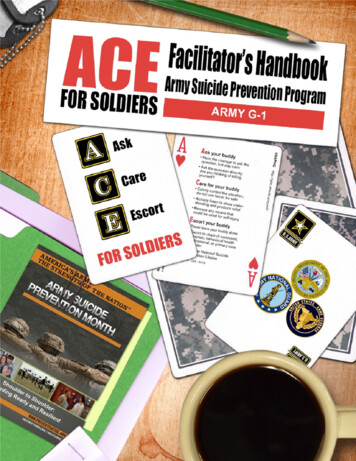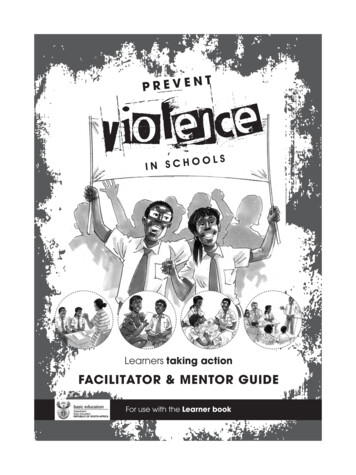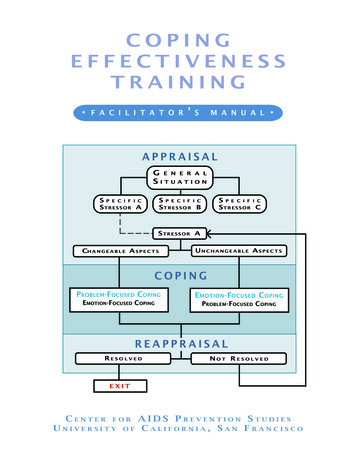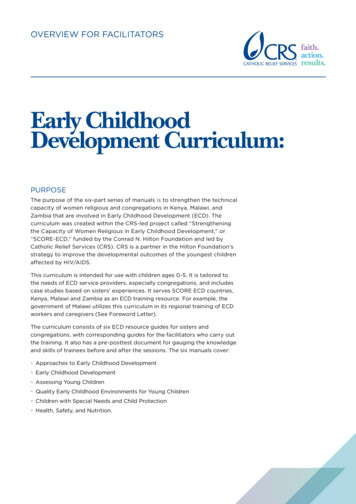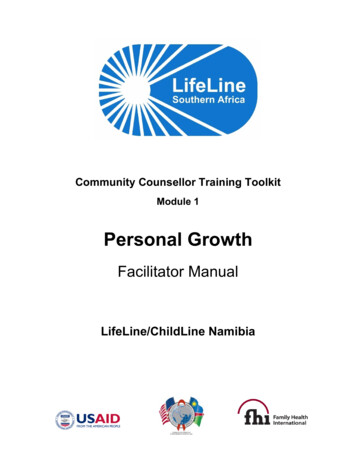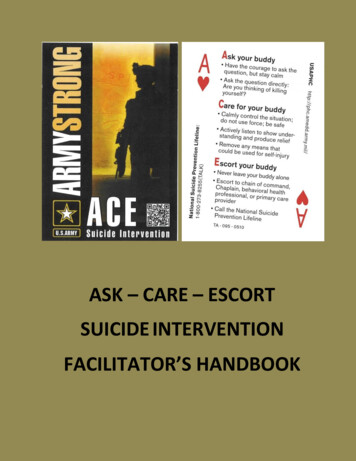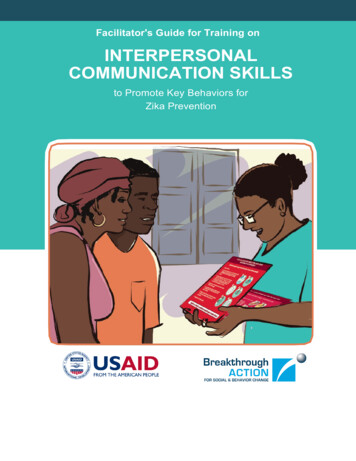
Transcription
Facilitator's Guide for Training onINTERPERSONALCOMMUNICATION SKILLSto Promote Key Behaviors forZika Prevention
AcknowledgmentsBreakthrough ACTION, a project funded by the United States Agency for InternationalDevelopment (USAID) and based at Johns Hopkins Center for Communication Programs,acknowledges the efforts of the team of professionals who helped to develop and improve thisFacilitator's Guide for Training on Interpersonal Communication Skills to Promote KeyBehaviors for Zika Prevention. We are especially grateful for the valuable direction andguidance of Patricia Poppe and Gabrielle Hunter in the development of this guide and toClaudia Nieves, who oversaw the final systematization and structuring of the guide. We are alsograteful for the valuable contributions of Berta Álvarez, Desireé Luis, and Eugenia Monterroso,Breakthrough ACTION Coordinators in Honduras, Guatemala, and the Dominican Republic,respectively, whose feedback strengthened the guide.We are grateful to Arianna Serino, MPH, USAID Technical Advisor for Zika Social andBehavioral Change, for her vision in developing this guide.We would also like to highlight the collaboration of Community Action on Zika, a project of Savethe Children and the International Federation of the Red Cross and Red Crescent Societies, inparticular Carla Sánchez and Marta Ortega, for their valuable contributions to the resourcesthat were used in the development of this project. Finally, we would like to thank the Technicaland Operational Performance Support project funded by USAID and the Food Security andNutrition Network, whose supportive supervision resources were used in this guide.1
This Facilitator's Guide was made possible by the generous support of the American peoplethrough the United States Agency for International Development (USAID) under theBreakthrough ACTION Cooperative Agreement #AID-OAA-A-17-00017. Breakthrough ACTIONis based at Johns Hopkins Center for Communication Programs (CCP). The content of this guideis the sole responsibility of Breakthrough ACTION and does not necessarily reflect the views ofUSAID, the United States government, or Johns Hopkins University.2
ContentsBefore you start: Instructions for the facilitator .4Learning objectives.6General outline of activities . 7Session 1 – Key messages for behaviors with the greatest potential to prevent Zika . 8Session 2 – Effective interpersonal communication . 15Session 3 – The 7Cs of effective communication . 21Session 4 – GATHER: How to conduct a home visit from start to finish . 25Session 5 – "Key Tips for Preventing Zika” communication tool . .31Session 6 – Supportive supervision of community volunteers or field promoters . 35Session 7 – How to replicate the training with community volunteers or promoters. 42Appendices . 473
Before you start: Instructions for the facilitatorThis guide is for facilitators who will lead the training in Interpersonal Communication Skillsfor the Promotion of Key Zika Prevention Behaviors. The guide provides step-by-stepinstructions on how to train field teams. The document includes teaching guides for theworkshop’s seven sessions, with each session including learning objectives, methodology,and activities. Teaching materials, resources needed for the sessions, and practicalexercises are included as appendices.The training uses recently collected data and information from Zika prevention projects in theregion regarding what people know and think about behaviors that prevent Zika transmissionand their motivators and barriers to adopting them.The workshop methodology follows an inductive teaching process based on the principles ofadult education, always taking into account what the trainee already knows, thinks, believes,and does. It incorporates participatory and practical exercises to strengthen interpersonalcommunication skills and dialog with families. The emphasis is on giving field teams tools topromote key behaviors in Zika prevention in the context of home visits.Based on the GATHER (Greet, Ask, Tell, Help, Explain, Review) method, participants areprovided with a structure to manage the information, tasks, and activities that are carried outbefore, during, and after each home visit, with special emphasis on the dynamics andinteraction between the volunteer and the family to achieve better impacts. Emphasis isplaced on active listening, asking questions, demonstrating behaviors, and encouragingcommitment.Finally, the topic of supportive supervision is also seen as an opportunity to supportsuccessful home visits and learn how to give feedback that encourages improvement ratherthan sanctioning or penalizing performance. This guide includes a tool for monitoringvolunteers’ performance during home visits and can that can also be used for selfevaluation.4
The guide is organized in the following sessions:Session 1. Key messages for the behaviors with the greatest potential to prevent ZikaSession 2. Effective interpersonal communicationSession 3. The 7Cs of effective communicationSession 4. GATHER: How to conduct a home visit from start to finishSession 5. "Key Tips for Preventing Zika” communication toolSession 6. Supportive supervision for community volunteers or field promotersSession 7. How to replicate this training with community volunteers or promotersA note on dengue, chikungunya and other diseasestransmitted by the Aedes aegypti mosquitoZika, dengue and chikungunya are viruses that cause different diseases. All three are spread bya mosquito bite from an infected Aedes aegypti. Unlike dengue and chikungunya, Zika can alsobe transmitted from a pregnant mother to her baby during pregnancy and through sexualintercourse.The methodology, content and exercises found in this “Facilitators Guide for Training onInterpersonal Communication Skills to Promote Key Behaviors for Zika Prevention” can beeasily adapted for use in programs against dengue, chikungunya or other diseases transmittedby the Aedes aegypti mosquito.Suggestions for incorporating dengue and chikungunya into this guide include the following:Session 1: Modify the behaviors with the greatest potential to prevent Zika (Appendix 1) tohighlight which behaviors also prevent dengue and chikungunya (Behaviors 1,3,4, and 5).Session 5: Use the communication tool “Key Tips for Preventing Zika, Dengue andChikungunya: A Guide for Home Visits” instead of “Key Tips for Preventing Zika: A Guide forHome Visits”Incorporate case studies, exercises and examples of dengue and chikungunya throughout theguide (Appendices 10,11,12)5
Intended audiencesThe primary audiences for this training are individuals in charge of field work teams (includingsupervisors, technicians, and liaisons) who implement Zika response activities.Learning objectivesGeneral objectivesAt the end of the workshop, participants will:1. Understand the importance of the interpersonal communication skills for home visits andhow to effectively promote the behaviors with the greatest potential to prevent Zika2. Understand and manage the technical contents and key messages of the behaviors with thegreatest potential to prevent Zika for effective interpersonal communication during homevisitsSpecific objectivesAt the end of the sessions, participants will:1. Identify and know how to communicate the key messages regarding the behaviors with thegreatest potential to prevent Zika during home visits2. Recognize the importance of effective interpersonal communication techniques to promotethe adoption of key Zika prevention behaviors3. Understand and implement the seven key elements of effective interpersonal communication4. Know how to conduct home visits using the GATHER methodology5. Understand the objectives, contents, and use of the “Key Tips for Preventing Zika” tool tosupport home visits regarding key Zika prevention behaviors6. Formulate a work plan to replicate this training with the field teams7. Learn supportive supervision techniques to use when accompanying field teams on homevisitsTotal training time: 24 hours6
General Activity OutlineTimeSessionObjectivesContent3 hours and15 minutesSession 1.Key messages for behaviorswith the greatest potential toprevent Zika Key messages for each behavior and priority groupKnow how to communicate keymessages about the behaviors with the Addressing myths, rumors, doubts, and barriers foreach behaviorgreatest potential to prevent Zika Discuss the benefits of adopting the behavior (forduring home visitsmother, child, family) Practice in pairs: demonstrations on how to practicevector control behaviors3 hours and15 minutesSession 2.Effective interpersonalcommunicationUnderstand the value of effectiveinterpersonal communication inpromoting key Zika preventionbehaviors Card activity: With whom do we talk for advice and toSession 3.The 7Cs of effectivecommunicationKnow the seven key elements ofeffective interpersonal communicationand put them into practice Command attention: Break the ice Cater to the heart and the head, and appeal to2 hours and45 minutesshare our doubts and problems? The intention of interpersonal communication is tohelp and guide others, not to order, impose, orscold. Types of interpersonal communication: directive,combined, and facilitating Cross-cutting characteristics Authenticity: Recognize our own attitudes, valuesand feelings Being conscious and respectful of differences Communication (verbal/nonverbal) Attentive/open listening Practice in pairsemotions, desires, and intellect Clarify the message, clarify myths, and incorrectinformation/beliefs Communicate the benefit: Facilitating factors foradopting Zika prevention behaviors Consistency of message across different channelsand information sources Create an environment of trust and credibility Call to action—Not only communicate but to invite toaction4 hours and45 minutesSession 4.GATHER: How to conducta home visit from start tofinish2 hours and30 minutesSession 5."Key Tips for PreventingZika” communication toolKnow how to conduct home visitsusing the GATHER methodologyUnderstand the objectives, contents,and use of the "Key Tips forPreventing Zika" tool Preparing for the home visit Steps during the visit—GATHER Practice in pairs: Home visit using GATHER Card contents How to use the cards during a home visit: How manybehaviors to work on in one visit; prioritization Practice in pairs: Home visits using the job aid andinterpersonal communication skills, emphasizing twobehaviors4 hours and15 minutesSession 6.Supportive supervision forcommunity volunteers orfield promotersUnderstand supportive supervisiontechniques to use whenaccompanying field teams on homevisits 3 hours and15 minutesSession 7.How to replicate thistraining with communityvolunteers or promotersFormulate a work plan to replicatethis training with field teams Know the Facilitator's Guide to Training inDefinition and objectivesWhat is the right attitude for supportive supervision?Tools and checklistHow to provide constructive feedbackKnow the checklistPractice in pairs: Home visitInterpersonal Communication Skills Explain the structure, modality, or methodology Develop a replication plan with communityvolunteers or promoters for each project Clarify any doubts Practice in teams24 hours7
Session 1Key messages for behaviors with the greatestpotential to prevent ZikaTime3 hours and 15 minutesHandouts Behaviors with the greatest potential to prevent Zika (Appendix 1) Icons of the priority groups for each key behavior (Appendix 2) Key messages for the behaviors with the greatest potential to prevent Zika (Appendix 3) Data matrix: What do people think and do in relation to the key Zika prevention behaviors?(Appendix 4) A fairy tale (Appendix 5) Checklist for home visits (Appendix 6)Learning objectiveKnow how to communicate key messages about the behaviors with the greatest potentialto prevent Zika during home visits.Description of the sessionDuring this session, the participants are welcomed and the agenda, the structure of theworkshop, and the behaviors with the greatest potential to prevent Zika are reviewed. Inaddition, the key messages for these behaviors are analyzed, along with common barriers thatprevent the behaviors from being adopted.8
TimeContentMethodologyMaterials15 minutesWelcome, presentworkshop objectives, andreview the agendaFacilitatorpresentation Objectives Agenda30 minutesExercise 1. Refresheron key Zika preventionbehaviors and thepriority groups for eachbehaviorMatch the target groupto the behavior Masking tape Box or basket Colored paper withExercise 2.Reviewing keymessages of Zikaprevention behaviorsPostersExercise 3. Clarifyingincorrect beliefs, myths,and misinformationClarifying myths60 minutes60 minutesthe behaviors with thegreatest potential toprevent Zika written onthem, one behavior persheet (Appendix 1) Icons of the prioritygroups for each keybehavior (Appendix 2) Masking tape Materials for creatingillustrative posters(markers, scissors,newspapers, coloredpaper, etc.) Key messages for thebehaviors with thegreatest potentialto prevent Zika(Appendix 3) Data matrix: What do 60 minutesEnd of session9Exercise 4. Practice inpairsSkitpeople think and do inrelation to the key Zikaprevention behaviors?(Appendix 4)Sheets of paperRed cardsMarkersA fairy tale (Appendix 5) Checklist for home visit(Appendix 6)
MethodologyExercise 1. Refresher on key Zika prevention behaviorsand the primary priority groups for each behaviorTo begin, have colored sheets of paper with the behaviors with the greatest potential toprevent Zika printed on them (Appendix 1). Post them on the wall before the workshop beginsand cover them so that they are not visible. Start the workshop by asking who rememberssome of the key behaviors uncovering the sheets as the behaviors are mentioned.Prepare a box or basket containing squares of paper with the icons of the priority groups foreach key behavior (Appendix 2) printed on them. These groups include the following: Pregnant women Partners of pregnant women Women of childbearing age Men Couples (men and women) FamiliesHand the box or basket to the group and ask each person to randomly select one picture andpaste it on the wall underneath the corresponding behavior. Continue the exercise until allicons have been placed. Some icons will correspond to more than one behavior and thisshould be made clear (see Appendix 2 and the table below). Answer questions andemphasize why it is important to know the priority groups for each behavior being promoted.Make sure the priority groups are classified correctly according to the following table:10
Behavioral priority groupsBehaviorUsing mosquito repellent throughout pregnancyPriority groupsPregnant womenPartners of pregnant womenUsing a condom every time you have sex duringpregnancyPregnant womenRemoving unintentional standing water both insideand outside of the house and in communal areasonce a week.FamiliesCovering water storage containers at all times with atight-fitting cover that does not warp or touch thewaterFamiliesScrubbing walls of water storage containers weekly toremove mosquito eggsFamiliesAttending prenatal check-ups to monitor pregnancyand learn about the risk of contracting Zika and how toprevent itPregnant womenPartners of pregnant women**Community leaders and neighborhood organizationsPartners of pregnant women**Prenatal care providersSeeking counseling from a trained provider on modernfamily planning methods if not planning on gettingpregnantWomen of childbearing ageMenCouples (men and women)** Although this guide focuses on the work of the volunteer or promoter during the homevisit, they may interact with other priority groups in other aspects of their work.11
Exercise 2. Reviewing key Zika prevention behavior messagesTo begin, have enough materials ready to make posters. Divide the group into seven teams andassign each one a key behavior. Give each group copies of the key messages regardingbehaviors with the greatest potential to prevent Zika (Appendix 3). The groups should reviewthe key messages and extract the most indispensable elements for discussing the behaviorduring home visits.Using the available materials, ask each group to make a poster that illustrates the followingelements of the assigned behavior (maximum of 15 minutes to work on the poster):1. Who is the audience?2. Who is responsible for the behavior?3. When and how often is it done?4. Key elements of how the behavior is carried out? This will be useful for doingdemonstrations during the visit. Have a maximum of four elements to limit theduration of the exercise.At the end of the exercise, the posters are placed in a visible location in the room. The groupthat made the poster for behavior #1, stands in front of the poster for behavior #2 and so onwith all of the groups, so that all participants review a behavior they did NOT work on.Each group should check whether the poster answers the questions it was supposed to addressand whether or not it contains the essential/key information. If anything is missing, the groupshould write that information on colored index cards and paste them next to the poster beingreviewed. They will have 10 minutes for their review. When the buzzer sounds, all groups willmove to the next behavior and so on until they have reviewed three posters.Closing. The facilitator reviews the posters quickly, reading aloud the information on the cardsthat were added and noting that everyone worked together to create the posters. Participantsare invited to visit the three remaining posters during a break or lunch or during the followingdays of the workshop and analyze them for completeness. They can take pictures of theposters and review them at home later.12
Exercise 3. Clarifying incorrect beliefs, myths, and misinformationNow that the audience knows the contents and the priority groups of the key behaviors to bepromoted during home visits, they must understand the barriers and motivators that influencewhether or not families adopt these behaviors. Distribute copies of the data matrix on whatpeople think and do in relation to key Zika prevention behaviors (Appendix 4). Explain that thisdocument can serve as a reference for them. Review what it contains and ask the group thefollowing questions:Why do these beliefs, myths, and inaccuracies (which act as barriers) exist?To what extent do they influence whether the person or families do or do not adoptthe promoted behaviors?We will now do an exercise on these barriers: Breaking down the wall.1. Use the same groups as in the previous exercise. Ask them toreview the information and the barriers of the assignedbehavior in the data matrix (Appendix 4)and if they believe there may be other beliefs, myths, rumors,or doubts that act as barriers and whether they recall hearingabout them when working with families.2. Each group writes the main barriers they have identified on redcards, using words or phrases such as, it hurts, it does notwork, it is expensive, etc. Place the cards on the floor or wall inbrick wall formation (see diagram). Time for this: 20 minutes.3. Each group also discusses how to break down the wall: Whatarguments can you use with the families you visit to bridge thegap and get them to take action? How can you motivate individuals and families and make thebenefits more visible? Write the answers on cards of a different color and place them on top ofthe bricks of the wall.To develop these arguments, the groups can refer to the data matrix (Appendix 4) and also usetheir own judgment and experience to identify the motivators or benefits families associatewith putting each behavior into practice.13
Closing. A fairy tale. All participants are seated. The facilitator reads the fairy tale (Appendix5) about what was covered in this session (behaviors, priority groups, beliefs, myths,misinformation, and motivations). This document contains errors regarding the concepts thatwere discussed in the session. The facilitator reads it aloud, slowly. When they identify anerror, participants stand up. The facilitator asks those who are standing why they think it isfalse, and those who remain seated why they believe it is true. Each participant can be givena copy of the story to underline the errors.Exercise 4. Practice in pairs - Clarifying myths Divide participants into pairs to work together on the practical exercises throughout theworkshop. Organize the pairs into groups of four people (two pairs in each group). In each group, one pair practices and the other pair observes and records using theChecklist for home visits (Appendix 6). Assign one of the Zika prevention behaviors to each group of four. Each pair decides who will act as a volunteer visiting the home and who will be amother, father, or mother-in-law receiving the volunteer. Ask the groups to demonstrate a home visit in which the community volunteer refers to: The key elements of the behavior Arguments to address the barriers presented by the person playing the other role(woman, partner, family, etc.) The pair that is observing writes their comments. In each group, the pairs then switch places. In closing, each pair shares written comments with the other pair.Closing. Ask them: How did you feel about the exercise? What was the hardest thing to do?What are the most difficult myths or barriers to address and demolish? What solution(motivators) did you find to address these barriers?NOTE to facilitator: Move around the room, observing the pairs, making note of thepositive elements and areas for improvement in interpersonal communication that youcan then discuss with the group.End of session. At the end of each session, thank the participants and ask for a volunteer toreview the highlights of the session.14
Session 2Effective interpersonal communicationTime3 hours and 15 minutesHandouts Checklist for home visits (Appendix 6) Images of the three types of interpersonal communication (Appendix 7) Definition and types of interpersonal communication (Appendix 8) Images of the four cross-cutting characteristics of effective interpersonal communication (Appendix 9) Case studies (Appendix 10)Learning objectiveUnderstand the value of effective interpersonal communication in promoting key Zikaprevention behaviors.Session descriptionThis session focuses on interpersonal communication and its importance, objectives, andcharacteristics. It also reviews three types of interpersonal communication and four key crosscutting characteristics to ensure good communication.15
TimeContentMethodologyMaterials10 minutesThe most importantthing about the previoussession20 minutesExercise 1. The goodcounselorMy advisors Colored index cards (1/4 letter) Markers Masking tape30minutesExercise 2. Interpersonalcommunication and typesof relationshipsBrainstorming and Key words of the interpersonalclassification Images of the three types ofExercise 3. Crosscutting elementsof interpersonalcommunicationSpider webExercise 4. Practice inpairs—Actively listeningSkit60 minutes60 minutescommunication definitioninterpersonalcommunication (Appendix 7) Strips of paper with thecharacteristics of the threetypes of communication Paper Definition and types ofinterpersonal communication(Appendix 8)classification Large skein of yarn Cards and markers Images of the four cross-cutting characteristics ofeffective interpersonalcommunication(Appendix 9) Checklist for home visits (Appendix6) Case studies(Appendix 10)End of session16
MethodologySummary of the previous session. Ask a volunteer or participant to recall the most importantthing from the previous session.Exercise 1. The good counselorDistribute colored cards and markers and ask participants to write down the name of a personthey seek out to talk about their problems and get advice and why they like to talk to this person(Example: My grandfather, because he is patient).Have everyone place their cards on the floor and form a circle around the cards. Ask for threevolunteers to tell the group what their card says. Then quickly read all the cards aloud and grouptogether those with similar elements.Closing - Ask the group:What do we look for in a counselor?What things do we not want from a counselor?What is the intention of counseling?Conclude the discussion, making sure the participants get the idea that the purpose ofcounseling is to help and guide the other person, respecting them, not giving orders,imposing, or scolding them. This idea is something to keep in mind when conductinghome visits.Exercise 2. Interpersonal communication and types of relationsWe have seen some of the aspects to be considered when receiving advice. Now ask thefollowing: How do people go about seeking advice from others? Write the answers on a flipchart. (The participants may say, for example, we get together and talk or chat, or we call eachother and talk on the phone.) Ask them: When we get together to talk, what are we doing?What is this called? (Reach the conclusion that this is communicating.)Now ask them: How many people are involved when we give/receive advice and communicate?When we give advice, are we providing information or exchanging information?(Participants will probably answer this question by saying that information is provided. Take theopportunity to show them that ideally there should be a two-way exchange of information ratherthan one-way communication.)17
As you discuss these questions, post the key words that define the concept of interpersonalcommunication on the wall.Exchange ofinformationVerbal andnonverbalBetween two ormore peopleFace to faceGeneratea solutionTransmitter andreceiverRead the complete definition aloud:"Interpersonal communication is the face-to-face verbal or nonverbal exchange ofinformation or feelings between individuals or groups that generates a solution and isnot merely the delivery of information.”Explain that communication can take various forms and place the titles of the three types ofcommunication on the wall. Below the titles, place the images exemplifying each one (Appendix 7).Without giving further explanations about the three types of communication, randomly distributethe strips of paper with the characteristics of the three types of communication among theparticipants and ask them to place them under the title they consider to be the right one.At the end, explain the types of communication in more detail and ask if there are any featuresthat need to be moved to a different position.Characteristics of the different types of esOne-way onlyAuthoritarian and maternalHorizontalVolunteer/promoter is activeVolunteer/promoter is activeVolunteer/promoter is a facilitatorFamily member is passiveFamily member is passiveFamily member participates, asks questionsLittle exchangeSome exchangeMore exchange of opinionsFearInsecurityMutual ritySome trustMore trust and empathyClosing. To conclude the exercise, emphasize the differences between the three types ofcommunication and distribute the handout on the definition and types of interpersonalcommunication (Appendix 8).18
Exercise 3. Cross-cutting elements of interpersonal communicationExplain that in this exercise you will begin to identify the essential elements of effectiveinterpersonal communication that must always be present when you are visiting and speakingwith families. Have a skein of yarn ready.Ask the participants to form a circle and ask them to think of a word that describes somethingthey have done in their home visits that has improved interpersonal communication, counseling,and dialogue with families. Give one of the people in the circle the skein of yarn and ask them tosay the word out loud and then throw the skein to someone else in the circle, who should do thesame, and so on until the skein is completely unrolled and looks like a spider’s web. At the endof the exercise, roll the skein back up and ask each participant to write his or her word on acard.Have the images of the four cross-cutting characteristics of good interpersonal communicationready (Appendix 9) and ask participants what they think each image on each poster represents.Once they have guessed, discuss each one of the four features, making sure to include thefollowing information.Active listeningPay attention to what people say and remember it. Do not think about what to say next whileother people are talking. Concentrate on what is being said and what it implies. Listenactively, consciously.Verbal and nonverbal communicationVerbal communication is the use of words and nonverbal communication (the use ofgestures, signs and body language). Participants must know how to “listen” to both forms ofcommunication. Being aware of nonverbal cues helps a person understand another personbetter. Body language, gestures, tone of voice, and the words one chooses influencecommunications and relationships, and can reinforce, contradict, substitute, supplement, oremphasize verbal communication.Respect differencesBe aware and respectful of the differences between you and the other person. There may becultural, educational, social, and other differences. Keep them in mind when giving advice,but do not create a divide in the relationship with the other
Development (USAID) and based at Johns Hopkins Center for Communication Programs, acknowledges the efforts of the team of professionals who helped to develop and improve this Facilitator's Guide for Training on Interpersonal Communication Skills to Promote Key Behaviors for Zika Prevention. We are especially grateful for the valuable direction and





